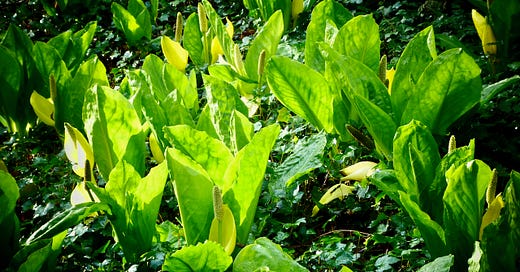In contrast to the epic atmospheric rivers of moisture bathing California and producing stunning superblooms in the desert, we in the PNW have had an arid spring, at least as Seattleites are used to experiencing weather. As of this week, my fair city is about 4.5 inches below our normal precipitation but that has not stopped one of my favorite wildflowers from creating very localized fields of beauty. If you want your own private superbloom far from floral fanatics, head to seeps and other wet spots, home to the skunk cabbage.
The great Linnaeus was the first to provide a scientific name for skunk cabbage (albeit one native to Japan and the Kamchatka Peninsula). He named it Dracontium foliis lanceolatis, or roughly “little lance leaved dragon,” if my Latin still serves me. Our species is now known as Lysichiton americanus, a reference to the spathe, or large yellow bract, that surrounds the flower spike. Shaped like a tunic, or chiton (a tunic worn by ancient Greeks and Romans), the spathe flares bright before withering and fading, a facet of life noted by the use of the Greek ly(si), meaning loosen or dissolve. The common name references the strong aroma, likened to carrion or feces, which attracts beetle and fly pollinators. Another popular name highlights the spathe and gives us swamp lantern.
As often happens in the literary world of nature, Henry D Thoreau was an early observer and commenter on skunk cabbage (the eastern species, Symplocarpus foetidus.) In his journal, he wrote: “If you are afflicted with melancholy at this season, go to the swamp and see the brave spears of skunk-cabbage buds already advanced toward a new year. Their gravestones are not bespoken yet. Is it the winter of their discontent? Do they seem to have lain down to die, despairing of skunk-cabbagedom? ‘Up and at ’em,’ ‘Give it to ’em,’ ‘Excelsior,’ ‘Put it through,’ — these are their mottoes.”
“Despairing of skunk-cabbagedom” creates such an eminently fine image but what’s curious about Mr. Thoreau’s observations is when he made them, on October 31, 1857. (Sorry, I cannot help answer the obvious and critical question as I haven’t a clue if Henry celebrated Halloween. If anyone has the scoop, please let us know in the comments.) His focus was on the autumnal fortitude of the plants, which can poke up their spathe tips in October and November; a botanist friend told me that “probably a small percentage do as a form of bet, hedging if winter is mild.”
As Thoreau often did, he illuminated an aspect of nature that others miss but I think that for many people, me included, the skunk cabbage’s appearance early in the year is a key harbinger of spring. (But since I am writing this more than a month after spring hath sprung, you might think of my newsletter as belated heraldry.) I always look forward to them rising in wet spots, their yolkian brilliance so in contrast to the muted colors of winter. They are a wetland’s joyous shout, quick and crystalline, of renewal and rebirth, that the essential destiny of verdurous life will once again return.
One reason skunk cabbage can appear so early, and relatively alone as a fleshy plant, is the calcium oxalate crystals in their leaves and bracts. Needlelike, the crystals cause whoever eats the plants “to suffer transcendent pain,” wrote Arthur Lee Jacobson, in Plants of Seattle. (I am pretty sure that he has eaten or attempted to eat more native plants in Seattle than anyone else.) Calcium oxalate is also found in many foods including spinach, rhubarb, and Swiss chard, as well as in kidney stones.
Although the spathe fades away, the leaves persist, emerald dragontails that can be five feet long. In this land of unrivaled vegetal exuberance, these brilliant shocks of green still draw attention and give the landscape a surprising tropical appearance. Right now though it’s time to celebrate the golden glow of the spathe but your time is limited as they will soon fade away, a sure sign that summer will also return.
Words of the week - Harbinger and herald - A herald, the officer who makes proclamations of state, dates back to the 1300s and quickly became synonymous with other less important reasons for spreading the news. Prior to this early date, a harbinger was one who provided lodgings (aka a harborer, which shares a similar root) and later one sent out to purvey the lodgings.
Book of the week - Spirit Whales and Sloth Tales: Fossils of Washington State - Alas, it won’t be out until October but this is the official UW Press page for it. I think the cover’s rather handsome.







I took a very wet road trip to Northern California at the beginning of April. I was too early for the super blooms with the exception of skunk cabbages! They were all along the roads near Ferndale, CA and the Redwoods. I'll be on the lookout for them here now.
One could say Thoreau at least noted Halloween-ish themes:
"I believe that men are generally still a little afraid of the dark, though the witches are all hung, and Christianity and candles have been introduced."
-From "Walden"; 1854